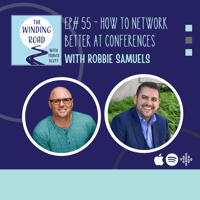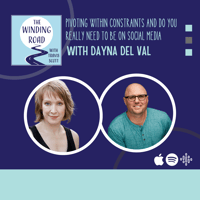Networking at conferences can be intimidating and many of us return home feeling like we left...
Networking Your Way to a New Job Using LinkedIn
.png?width=450&height=450&name=Winding%20Road%20Podcast%20Cover%20-%20Feed%20(2).png)
There's a lot of competition for marketing jobs right now and the traditional "spray and pray" isn't working.
The recent layoffs have been frequent and furious (not to mention gross). Companies, in their infinite lack of long-term thinking, are laying off marketers in droves. Not only will this kill any kind of momentum they've built for their brand and demand generation, but it's left a lot of talented people searching for their next role.
With so much competition and the fact that companies have also cut their recruiting staffs, the traditional "spray and pray," that never worked in the past, really doesn't work now.
So, how can you stand out amongst the "crowd" of others in the same boat as you?
I recently sat down with Emily Mireault to learn more about how she leveraged the power of LinkedIn to land her current role after she had been laid off.
Identify Your Target Audience
As Seth Godin says, the key to marketing anything, including yourself, is to know "what you're for" and "who you're for."
The "what you're for" is probably pretty clear; maybe you're a demand gen marketer, content creator, email marketer, SEO specialist. That part you have down.
The "who you're for" part is probably a little more difficult to nail down, but maybe more important.
I get it, maybe at this point, you just need a job and that's fine. But once you've landed on your feet and you're ready to get back on track with the next logical step in your career, it's important to understand what you want out of your next company.
How much autonomy? How much creative freedom will you have to continue to create and engage on platforms like LinkedIn will you have? Will you be challenged and continue to grow? What's the expected time commitment? Do they sell something you're interested in?
Many, if not all, of these things will factor into the types of companies you'll want to target.
Once you have your list pulled together, then it's time to use LinkedIn to start finding people to connect with at these companies.
Here is some basic criteria to use when connecting:
- Connect with people who are active on LinkedIn
- Connect with people who have a large following
- Connect with people who are in leadership roles within the company
- Connect with people who would be your peers if you worked there
If their profile has a bell icon in the right corner, click that so you'll be notified when they post something.
When Emily was trying to identify people to connect with she said that she "loved the startup space and I wanted to (connect with) small and scrappy companies." She went on to say, "I connect best with marketers and salespeople because that's typically who's active on LinkedIn."
Be Consistent (and Persistent)
When you decide to start creating more content, whether it's on LinkedIn, a newsletter, YouTube videos, or something else, the key is being consistent. Just like in advertising frequency is also important. The more people see you show up in your feed, the more they feel they get to know you and understand what you're all about.
If you're looking for a new role, staying top of mind is crucial because 90% of the time you show up in someone's feed, they don't know of an open job but if you're consistently in front of them and clear on who you're for and what you're for, you'll be the first person that comes to mind when someone in your audience stumbles across a role that you would be perfect for.
Persistence is important too. Not everything you post is going to land like you thought it would. Most of the time, when I feel like I've written something really helpful it lands with a thud and other times I post something stupid or what I feel is insignificant and it blows up. You just never know, so publish it anyway and don't take the vanity metrics personal. Just because someone doesn't "like" something doesn't mean they didn't see it. The views on your posts always outnumber the engagement and that's perfectly fine.
Prior to looking for her next role, Emily was only posting one a week or sometimes two or three times per week. Once she got serious about using LinkedIn she upped her posting schedule to twice per day.
As far as timing, she experimented with posting at various times and ultimately landed on morning and evening. "I posted generally between seven and 8:00 AM and generally between seven and 8:00 PM (US Central Time)." She went on to say, "there was more activity at those times as people were gearing up for the day or winding down from the day."
Become an Advocate for the Brands You Admire
Once you've identified the companies you want to work for- because you genuinely admire them - become an advocate for them on LinkedIn.
Emily showed up on LinkedIn in this way when other people would ask questions like "what companies would you recommend for X, Y, Z?" She said that she, "started to like become this evangelist or this advocate for brands I wasn't even working for and I started tagging companies like Nectar, companies like Lavender; companies that are just doing these things really well." This got her noticed because, "somebody was managing those pages," she added.
Show Up in the Comments
Lastly, it's not all about you posting and creating content all the time. One of, if not THE, most effective things you can do on LinkedIn to get noticed by the people you want to get in front of is to live in the comments on LinkedIn.
What that means is to comment on posts that your target audience is sharing. It can't just be rote things like "great point" or "I agree 100%"; it needs to add value or demonstrate your perspective on the topic.
In hindsight, Emily thinks she could have landed her next role much faster if she had spent more time in the comments. She said," if I went back and did it, I think I actually could have landed a job even sooner if I had been really active in comment sections." An interesting insight she gained was to use the comments section not only to advocate for herself, but "advocating for others, like lifting other people up and hyping them up helps just as much as hyping yourself up." This gets you noticed by the people you're lifting up and could foster reciprocity, but the most important thing is helping others. It doesn't go unnoticed and unappreciated.
If you're part of the many, many marketers currently on the job market and not as active on LinkedIn as you should be, it might be tie to change that.
BTW...Emily also published a children's book called Easter the Pig that's now available on Amazon. If you have kids, give it a look.
Are you looking for a job and feel like you need some guidance? I offer new way of coaching using asynchronous voice messaging. If you'd like to tap into my experience of being a former recruiter along with my deep understanding of marketing careers, consider my 6- week coaching program.
-1.png?width=400&height=100&name=Website%20Logo%20-%20400x100%20(transparent%20background)-1.png)


